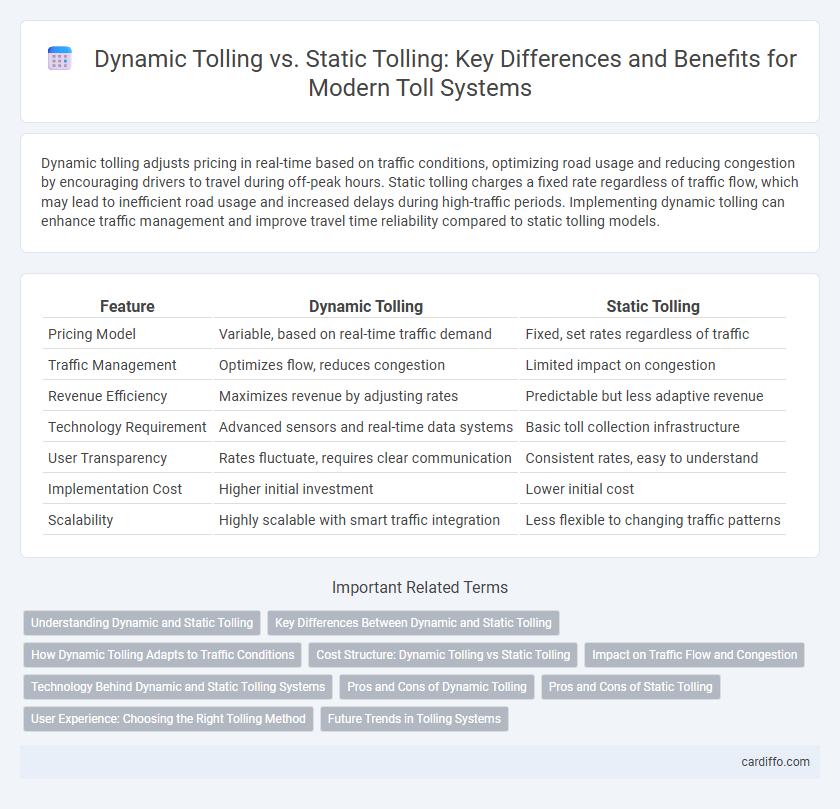Dynamic tolling adjusts pricing in real-time based on traffic conditions, optimizing road usage and reducing congestion by encouraging drivers to travel during off-peak hours. Static tolling charges a fixed rate regardless of traffic flow, which may lead to inefficient road usage and increased delays during high-traffic periods. Implementing dynamic tolling can enhance traffic management and improve travel time reliability compared to static tolling models.
Table of Comparison
| Feature | Dynamic Tolling | Static Tolling |
|---|---|---|
| Pricing Model | Variable, based on real-time traffic demand | Fixed, set rates regardless of traffic |
| Traffic Management | Optimizes flow, reduces congestion | Limited impact on congestion |
| Revenue Efficiency | Maximizes revenue by adjusting rates | Predictable but less adaptive revenue |
| Technology Requirement | Advanced sensors and real-time data systems | Basic toll collection infrastructure |
| User Transparency | Rates fluctuate, requires clear communication | Consistent rates, easy to understand |
| Implementation Cost | Higher initial investment | Lower initial cost |
| Scalability | Highly scalable with smart traffic integration | Less flexible to changing traffic patterns |
Understanding Dynamic and Static Tolling
Dynamic tolling adjusts toll rates based on real-time traffic conditions to manage congestion and optimize road usage, using data-driven algorithms to vary prices throughout the day. Static tolling sets fixed charges regardless of traffic flow, offering predictability but lacking flexibility to address fluctuating demand. Understanding the distinction aids in evaluating transportation efficiency, cost-effectiveness, and potential environmental impacts of tolling strategies.
Key Differences Between Dynamic and Static Tolling
Dynamic tolling adjusts prices in real-time based on traffic conditions, demand, and congestion levels, optimizing road usage and reducing delays. Static tolling involves fixed rates regardless of traffic patterns, offering predictability but less efficiency during peak hours. Key differences include price flexibility, traffic management effectiveness, and impact on driver behavior and congestion mitigation.
How Dynamic Tolling Adapts to Traffic Conditions
Dynamic tolling adjusts toll rates based on real-time traffic data, using sensors and algorithms to optimize traffic flow and reduce congestion. This adaptive pricing model encourages drivers to alter travel times or routes, balancing demand and maintaining steady speeds. Static tolling, by contrast, applies fixed rates regardless of traffic conditions, often leading to inefficiencies during peak hours.
Cost Structure: Dynamic Tolling vs Static Tolling
Dynamic tolling features a flexible cost structure that adjusts rates based on real-time traffic patterns, reducing congestion and optimizing revenue during peak hours. Static tolling maintains fixed fees regardless of traffic conditions, providing predictable but less efficient revenue streams. Cost savings in dynamic tolling arise from improved traffic flow and reduced infrastructure strain, while static tolling incurs consistent operational costs without demand-responsive adjustments.
Impact on Traffic Flow and Congestion
Dynamic tolling adjusts prices based on real-time traffic conditions, effectively managing congestion by incentivizing off-peak travel and optimizing roadway capacity. Static tolling imposes fixed fees regardless of traffic volume, often leading to unmanaged congestion during peak periods and underutilized capacity during off-peak times. Studies show dynamic tolling reduces traffic congestion by up to 15%, improving overall traffic flow and decreasing travel time variability.
Technology Behind Dynamic and Static Tolling Systems
Dynamic tolling systems utilize advanced technologies such as real-time traffic sensors, GPS data analytics, and AI algorithms to adjust toll rates based on traffic flow and congestion levels. Static tolling systems rely on pre-set toll rates programmed into electronic toll collection devices, using RFID transponders or ANPR (automatic number plate recognition) cameras for vehicle identification. The integration of cloud computing and IoT in dynamic tolling enhances data processing speed and accuracy, enabling more efficient traffic management compared to the fixed-rate static tolling infrastructure.
Pros and Cons of Dynamic Tolling
Dynamic tolling adjusts prices based on real-time traffic conditions, helping to reduce congestion by encouraging off-peak travel and balancing roadway usage. This system optimizes revenue generation and improves traffic flow but can create unpredictability for drivers and requires advanced monitoring technology. Static tolling provides consistent rates, offering simplicity and predictability, but may fail to alleviate peak-hour congestion effectively.
Pros and Cons of Static Tolling
Static tolling offers predictable and consistent toll rates, making budgeting straightforward for frequent commuters and transport companies. However, it can lead to traffic congestion during peak hours as toll prices remain unchanged regardless of real-time demand, potentially reducing road efficiency. The lack of price flexibility limits the ability to manage traffic flow dynamically and optimize infrastructure usage.
User Experience: Choosing the Right Tolling Method
Dynamic tolling adjusts prices based on real-time traffic conditions, reducing congestion and improving travel time reliability for users. Static tolling maintains fixed rates regardless of traffic, offering predictability but often leading to inefficiencies during peak hours. Prioritizing user experience, dynamic tolling provides adaptive pricing that balances road demand and enhances overall satisfaction by minimizing delays.
Future Trends in Tolling Systems
Dynamic tolling leverages real-time data analytics, AI algorithms, and IoT sensors to adjust toll rates based on traffic congestion, optimizing roadway efficiency and reducing emissions. Future trends indicate increased adoption of connected vehicle technology and blockchain for secure, transparent transactions, enhancing toll system accuracy and user convenience. Integration with smart city infrastructure will enable seamless mobility management, promoting sustainable transportation and adaptive pricing strategies.
Dynamic Tolling vs Static Tolling Infographic

 cardiffo.com
cardiffo.com